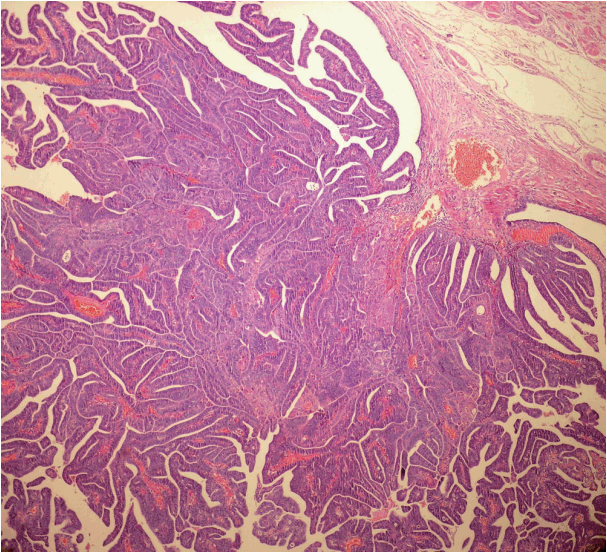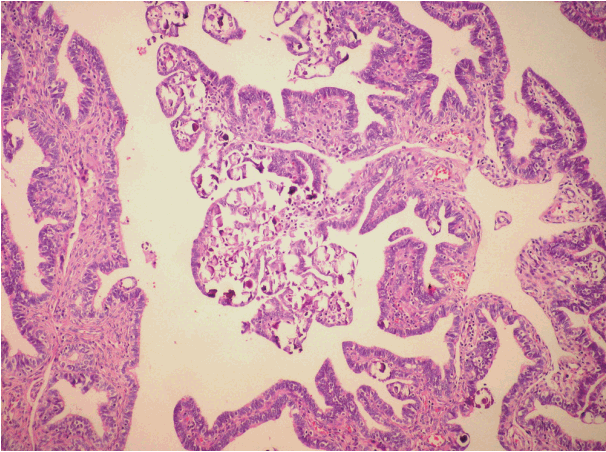Articles
- Page Path
- HOME > J Pathol Transl Med > Volume 52(1); 2018 > Article
-
Original Article
Comparison of the Classical Method and SEE-FIM Protocol in Detecting Microscopic Lesions in Fallopian Tubes with Gynecological Lesions - Nermin Koc, Selçuk Ayas1, Sevcan Arzu Arinkan,1
-
Journal of Pathology and Translational Medicine 2018;52(1):21-27.
DOI: https://doi.org/10.4132/jptm.2016.06.17
Published online: August 19, 2016
Department of Pathology, Zeynep Kamil Maternity and Pediatric Research and Training Hospital, Istanbul, Turkey
1Department of Obstetrics and Gynecology, Zeynep Kamil Maternity and Pediatric Research and Training Hospital, Istanbul, Turkey
- Corresponding Author Sevcan Arzu Arinkan, MD Department of Obstetrics and Gynecology, Zeynep Kamil Maternity and Pediatric Research and Training Hospital, Istanbul 34660, Turkey Tel: +90-505-683-7557 E-mail: pataraa96@gmail.com
© 2018 The Korean Society of Pathologists/The Korean Society for Cytopathology
This is an Open Access article distributed under the terms of the Creative Commons Attribution Non-Commercial License (http://creativecommons.org/licenses/by-nc/4.0) which permits unrestricted non-commercial use, distribution, and reproduction in any medium, provided the original work is properly cited.
Figure & Data
References
Citations

- Volumetric sonographic depiction of the fallopian tube lumen for the early detection of tubal abnormalities: A work in progress
Jessica P. Miller, Ryan G. Morrison, Emily Mechling, Karen Tisdale, Katherine Frederick-Dyer, Brannan B. Griffin, Ben H. Park, Lauren S. Prescott, Marta A. Crispens, Ronald Alvarez, Arthur Fleischer
WFUMB Ultrasound Open.2024; 2(1): 100031. CrossRef - ESGO–ESMO–ESP consensus conference recommendations on ovarian cancer: pathology and molecular biology and early, advanced and recurrent disease
J.A. Ledermann, X. Matias-Guiu, F. Amant, N. Concin, B. Davidson, C. Fotopoulou, A. González-Martin, C. Gourley, A. Leary, D. Lorusso, S. Banerjee, L. Chiva, D. Cibula, N. Colombo, S. Croce, A.G. Eriksson, C. Falandry, D. Fischerova, P. Harter, F. Joly, C
Annals of Oncology.2024; 35(3): 248. CrossRef - Incidental Serous Tubal Intraepithelial Carcinoma Finding in a Nepalese Patient Undergoing Opportunistic Salpingectomy and the Discovery of a BRCA1 Pathogenic Variant
Kristin M. Tischer, Siddhartha Yadav, Debra Bell, Kathleen Hansen, Larissa N. Veres, Brandon Maddy, Jamie N. Bakkum-Gamez
O&G Open.2024; : 009. CrossRef - Prevention of Ovarian Cancer: Where are We Now and Where are We Going?
Isabel V. Rodriguez, Talayeh Ghezelayagh, Kathryn P. Pennington, Barbara M. Norquist
Current Oncology Reports.2024; 26(11): 1355. CrossRef - Prophylactic Radical Fimbriectomy with Delayed Oophorectomy in Women with a High Risk of Developing an Ovarian Carcinoma: Results of a Prospective National Pilot Study
Eric Leblanc, Fabrice Narducci, Gwenaël Ferron, Audrey Mailliez, Jean-Yves Charvolin, El Houssein, Frédéric Guyon, Virginie Fourchotte, Eric Lambaudie, Agathe Crouzet, Yves Fouche, Sébastien Gouy, Pierre Collinet, Frédéric Caquant, Christophe Pomel, Franç
Cancers.2023; 15(4): 1141. CrossRef - Consensus based recommendations for the diagnosis of serous tubal intraepithelial carcinoma: an international Delphi study
Joep M A Bogaerts, Majke H D van Bommel, Rosella P M G Hermens, Miranda P Steenbeek, Joanne A de Hullu, Jeroen A W M van der Laak, Michiel Simons
Histopathology.2023; 83(1): 67. CrossRef - Quality of life after risk-reducing surgery for breast and ovarian cancer prevention: a systematic review and meta-analysis
Xia Wei, Samuel Oxley, Michail Sideris, Ashwin Kalra, Adam Brentnall, Li Sun, Li Yang, Rosa Legood, Ranjit Manchanda
American Journal of Obstetrics and Gynecology.2023; 229(4): 388. CrossRef - Adherence to risk-reducing salpingo-oophorectomy guidelines among gynecologic oncologists compared to general gynecologists
Pegah Blustein, Sarah R. Werner, Pooja Uppalapati, Tung Ming Leung, Gregg A. Husk, Elena B. Pereira, Jill S. Whyte, Jeannine A. Villella
American Journal of Obstetrics and Gynecology.2023; 229(3): 280.e1. CrossRef - Intraluminal tumor cells and prognostic accuracy of endometrial cancer stage criteria: A multi-institution study
Ashley S. Felix, Jennifer A. Sinnott, David E. Cohn, Máire A. Duggan, Laura J. Havrilesky, Alexander B. Olawaiye, Andrea Mariani, Monica Rodriquez, Mary Anne Brett, Giorgia Dinoi, Caitlin E. Meade, Bobbie Hall, Ester Goldfeld, Esther Elishaev, Mark E. She
Gynecologic Oncology.2023; 178: 130. CrossRef - Recommendations for diagnosing STIC: a systematic review and meta-analysis
Joep M. A. Bogaerts, Miranda P. Steenbeek, Majke H. D. van Bommel, Johan Bulten, Jeroen A. W. M. van der Laak, Joanne A. de Hullu, Michiel Simons
Virchows Archiv.2022; 480(4): 725. CrossRef - Magnetic resonance imaging findings of extrauterine high-grade serous carcinoma based on new pathologic criteria for primary site assignment
Masaya Kawaguchi, Hiroki Kato, Yuichiro Hatano, Hiroyuki Tomita, Akira Hara, Tatsuhiko Miyazaki, Masayuki Matsuo
Acta Radiologica.2021; 62(5): 687. CrossRef - Role of Routine Peritoneal Biopsies During Risk Reducing Salpingo-Oophorectomy (RRSO)
Therese Pross, Maria Margarete Karsten, Jens-Uwe Blohmer, Dorothee Speiser
Geburtshilfe und Frauenheilkunde.2021; 81(09): 1031. CrossRef - Histomorphological Spectrum of Incidentally Detected Fallopian Tube Lesions in Patients Operated for Various Clinical Conditions and Detection of Precursor Lesion by Applying Sectioning and Extensively Examining the Fimbriated End Sampling Protocol
Neha Singh, Ipsita Dhal, Aneesha Mohanpuria, Swati Saxena
Oncology Journal of India.2021; 5(3): 85. CrossRef - Risk-reducing Bilateral Salpingo-oophorectomy: Assessing the Incidence of Occult Ovarian Cancer and Surgeon Adherence to Recommended Practices
Laura K. Newcomb, Coralee T. Toal, Noah B. Rindos, Li Wang, Suketu M. Mansuria
Journal of Minimally Invasive Gynecology.2020; 27(7): 1511. CrossRef - Serous Tubal Intraepithelial Carcinoma: A Concise Review for the Practicing Pathologist and Clinician
S. Emily Bachert, Anthony McDowell, Dava Piecoro, Lauren Baldwin Branch
Diagnostics.2020; 10(2): 102. CrossRef - An Alternate Diagnostic Algorithm for the Diagnosis of Intraepithelial Fallopian Tube Lesions
Marie E. Perrone, Nicholas P. Reder, Sergay N. Agoff, Rochelle L. Garcia, Kathy J. Agnew, Barbara M. Norquist, Kathryn P. Pennington, Elizabeth M. Swisher, Mark R. Kilgore
International Journal of Gynecological Pathology.2020; 39(3): 261. CrossRef - Inherited mutations in fallopian tube, ovarian and primary peritoneal carcinoma: Changes in diagnoses and mutational frequency over 20 years
Arielle S. Weiss, Elizabeth Swisher, Kathryn P. Pennington, Marc Radke, Nithisha Khasnavis, Rochelle L. Garcia, Mark R. Kilgore, Ming K. Lee, Barbara M. Norquist
Gynecologic Oncology.2020; 159(1): 214. CrossRef - Grossing Issues in Ovarian and Fallopian Tube Pathology
Lakshmi Shree Kulumani Mahadevan, Byoung Uk Park, I-Tien Yeh
AJSP: Reviews and Reports.2020; 25(4): 174. CrossRef - Ovarian Serous Carcinoma: A Retrospective Study of Clinicopathological Findings and Postchemotherapy Changes
Navatha Vangala, Shantveer G Uppin, Megha S Uppin, Tara Roshni Paul, G Sadashivudu
Indian Journal of Medical and Paediatric Oncology.2020; 41(05): 663. CrossRef - Sectioning and extensively examining the fimbriated end (SEE‐FIM) of the fallopian tube in routine practices, is it worth the effort?
Natthawadee Laokulrath, Malee Warnnissorn, Tuenjai Chuangsuwanich, Suchanan Hanamornroongruang
Journal of Obstetrics and Gynaecology Research.2019; 45(3): 665. CrossRef - Endometrial Carcinoma, Grossing and Processing Issues: Recommendations of the International Society of Gynecologic Pathologists
Anais Malpica, Elizabeth D. Euscher, Jonathan L. Hecht, Rouba Ali-Fehmi, Charles M. Quick, Naveena Singh, Lars-Christian Horn, Isabel Alvarado-Cabrero, Xavier Matias-Guiu, Lynn Hirschowitz, Máire Duggan, Jaume Ordi, Vinita Parkash, Yoshiki Mikami, M. Ruhu
International Journal of Gynecological Pathology.2019; 38(Supplement): S9. CrossRef - Screening and surgical prophylaxis for hereditary cancer syndromes with high risk of endometrial and ovarian cancer
Alexandra S. Bercow, Eric L. Eisenhauer
Journal of Surgical Oncology.2019; 120(5): 864. CrossRef - Risk-reducing bilateral salpingo-oophorectomy in women with BRCA1 or BRCA2 mutations
George U Eleje, Ahizechukwu C Eke, Ifeanyichukwu U Ezebialu, Joseph I Ikechebelu, Emmanuel O Ugwu, Onyinye O Okonkwo
Cochrane Database of Systematic Reviews.2018;[Epub] CrossRef - Risk-reducing bilateral salpingo-oophorectomy in women with BRCA1 or BRCA2 mutations
George U Eleje, Ahizechukwu C Eke, Ifeanyichukwu U Ezebialu, Joseph I Ikechebelu, Emmanuel O Ugwu, Onyinye O Okonkwo
Cochrane Database of Systematic Reviews.2016;[Epub] CrossRef
 PubReader
PubReader ePub Link
ePub Link-
 Cite this Article
Cite this Article
- Cite this Article
-
- Close
- Download Citation
- Close
- Figure



Fig. 1.
Fig. 2.
Fig. 3.
| Pathology | Classical method (n = 582) | SEE-FIM protocol (n = 536) |
|---|---|---|
| Endometrial carcinoma | 210 | 48 |
| Non-uterine pelvic malignant tumor | ||
| Ovarian malignant tumors | 150 | 49 |
| Tubal malignant tumor | 11 | 9 |
| Peritoneal carcinoma | 5 | 3 |
| Ovarian borderline tumor | 44 | 17 |
| Premalignant and benign lesions, other tumors |
162 | 410 |
| Variable | Classical method (n = 185) | SEE-FIM protocol (n = 40) |
|---|---|---|
| Age, mean (yr) | 60 | 61 |
| Tumor grade | ||
| 1 | 58 | 14 |
| 2 | 70 | 18 |
| 3 | 57 | 8 |
| Myometrial invasion | ||
| None | 34 | 8 |
| < 1/2 | 78 | 20 |
| > 1/2 | 73 | 12 |
| Lymph node metastasis | 14 | 4 |
| Extrauterine extension | 9 | 5 |
| No. of cases with tubal infiltrative carcinoma |
2 | 0 |
| Case No. | Age (yr) | Primary tumor type | Myometrial involvement | Primary tumor grade | Localization of tubal involvement | Size of tubal involvement (cm) | Other metastatic sites |
|---|---|---|---|---|---|---|---|
| 1 | 38 | Endometrioid | < 1/2 | 1 | Fimbrial | 0.2 | Ovary, cervix |
| 2 | 56 | Endometrioid | > 1/2 | 2 | Ampullary | 0.3 | None |
| Histopathology | Classical method | STIC cases | SEE-FIM | STIC cases |
|---|---|---|---|---|
| Ovary high-grade serous carcinoma | 85 | 0 | 28 | 10 (35) |
| Ovary low-grade serous carcinoma | 12 | 0 | 3 | 0 |
| Ovary nonserous carcinoma |
53 | 0 | 18 | 0 |
| Tubal serous carcinoma | 11 | 1 (9) | 8 | 4 (50) |
| Tubal nonserous carcinoma |
0 | 0 | 1 | 0 |
| Peritoneum | 5 | 0 | 3 | 1 (33) |
| Total No. of cases |
156 | 1 | 4 | 15 |
| Variable | Classical method (n = 31) | SEE-FIM protocol (n = 13) |
|---|---|---|
| Age, mean (yr) | 44 | 40 |
| Bilateral | 24 | 9 |
| Microinvasion | 8 | 5 |
| Implant |
3 | 2 |
| Endosalpingiosis | 2 | 1 |
| No. of cases with papillary tubal hyperplasia | 2 | 7 |
SEE-FIM, Sectioning and Extensively Examining the Fimbriated End Protocol. Premalignant lesions (endometrial hyperplasia, cervical intraepithelial lesions), benign lesions (endometrial polyp, myoma), carcinomas of the cervix, vagina, and vulva.
SEE-FIM, Sectioning and Extensively Examining the Fimbriated End Protocol. p = .031.
Values are presented as number (%). STIC, serous tubal intraepithelial carcinoma; SEE-FIM, Sectioning and Extensively Examining the Fimbriated End Protocol. Endometrioid, clear cell, mucinous, Krukenberg, malignant mixed mullerian tumor, granulosa; Endometrioid; p < .001.
SEE-FIM, Sectioning and Extensively Examining the Fimbriated End Protocol. Implants are noninvasive and nondesmoplastic.

 E-submission
E-submission








